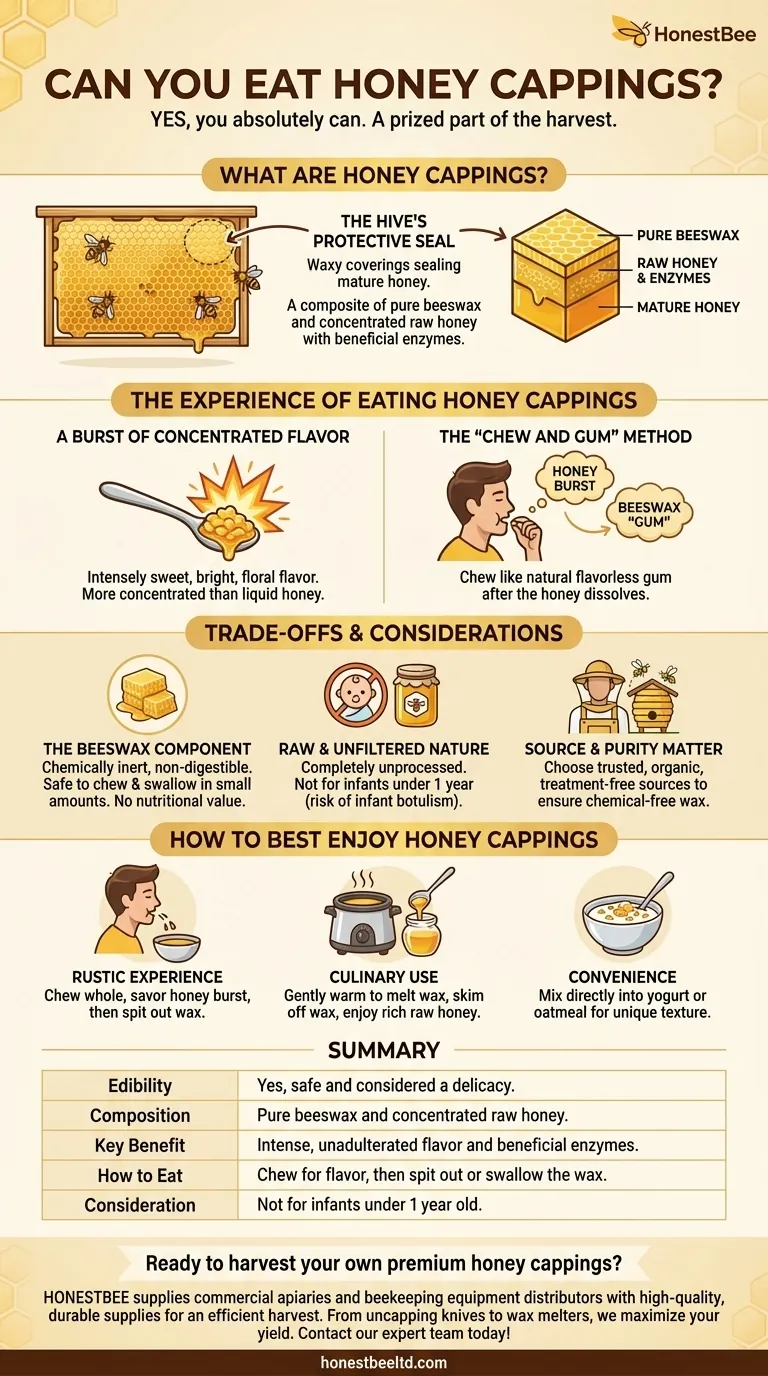Yes, you can absolutely eat honey cappings. In fact, for many beekeepers and honey connoisseurs, they are considered a prized part of the harvest. These waxy coverings seal the honeycomb cells and are a composite of pure beeswax and the freshest, most concentrated raw honey, offering a unique texture and flavor you won't find in a jar.
Honey cappings are not just an edible byproduct; they are a distinct and flavorful part of the raw honeycomb experience. They combine beeswax, raw honey, and trace enzymes into a unique, chewable treat that represents the most unadulterated product from the hive.

What Exactly Are Honey Cappings?
To appreciate cappings, it’s important to understand their role within the hive. They are far more than just a simple wrapper.
The Hive's Protective Seal
Bees fill honeycomb cells with nectar, which they dehydrate into honey. Once the honey reaches the perfect moisture content (around 17-18%), the bees seal the cell with a fresh layer of beeswax. This "capping" protects the mature honey from moisture and contaminants, preserving it indefinitely.
A Composite of Pure Ingredients
When a beekeeper harvests honey, they first slice off this top layer of cappings. The resulting material is a mixture of pure beeswax and the raw honey that was stored directly against it. It often contains higher concentrations of beneficial enzymes like diastase and invertase, as bees secrete them onto the honey's surface just before capping.
The Experience of Eating Honey Cappings
Eating cappings is a different sensory experience than consuming liquid honey. It’s more rustic and interactive.
A Burst of Concentrated Flavor
The most common way to enjoy cappings is to simply take a small spoonful and chew. You'll immediately get a burst of intensely sweet, raw honey. The flavor is often brighter and more floral than liquid honey from the same batch because it hasn't been exposed to air or processing.
The "Chew and Gum" Method
After the honey dissolves in your mouth, you are left with the beeswax. At this point, you have two options. Many people continue to chew the wax like a natural, flavorless chewing gum. The reference to it being like "gum" is very accurate.
Understanding the Trade-offs and Considerations
While entirely natural and safe, there are a few points to keep in mind for the best experience.
The Beeswax Component
Beeswax is chemically inert and non-digestible by humans. While swallowing small amounts is harmless and will simply pass through your system, it provides no nutritional value. If you eat a large quantity of cappings, it's generally advisable to spit out the wax once the honey is gone.
Raw and Unfiltered Nature
Because cappings are completely unprocessed, they are the definition of raw honey. This means they should not be given to infants under one year of age due to the risk of infant botulism, the same precaution that applies to all raw honey.
Source and Purity Matter
The best honey cappings come from trusted beekeepers who manage their hives using organic, treatment-free practices. This ensures the wax is free from any potential agricultural chemicals or in-hive treatments.
How to Best Enjoy Honey Cappings
Your approach to eating cappings can vary based on what you want to get out of the experience.
- If your primary focus is the pure, rustic experience: Chew a small piece of the cappings whole, savoring the burst of honey, and then spit out the remaining wax.
- If your primary focus is culinary use: Gently warm the cappings to melt the wax, which will separate and rise to the top. You can then skim off the beeswax (and save it for other uses) and enjoy the incredibly rich, raw honey that remains.
- If your primary focus is convenience: Mix the cappings directly into yogurt or oatmeal. The wax adds a unique texture that some people find very pleasant, similar to eating a whole piece of honeycomb.
Eating honey cappings allows you to enjoy the work of the bees in its most complete and unadulterated form.
Summary Table:
| Aspect | Details |
|---|---|
| Edibility | Yes, safe and considered a delicacy. |
| Composition | Pure beeswax and concentrated raw honey. |
| Key Benefit | Intense, unadulterated flavor and beneficial enzymes. |
| How to Eat | Chew for flavor, then spit out or swallow the wax. |
| Consideration | Not for infants under 1 year old. |
Ready to harvest your own premium honey cappings? HONESTBEE supplies commercial apiaries and beekeeping equipment distributors with the high-quality, durable supplies needed for an efficient and productive harvest. From uncapping knives to wax melters, our wholesale-focused operations ensure you get the professional-grade equipment required to maximize your yield. Let us help you deliver the purest hive products to your market. Contact our expert team today to discuss your wholesale needs!
Visual Guide

Related Products
- Honey Wax Separating Wax Press with Metal Screw Wax Separator Machine
- Colorful Silicone Beeswax Foundation Mold Mould for Beekeeping
- Stainless Steel Manual Honey Press with Guard for Pressing Honey and Wax
- Honeycomb Style Drip Free Honey Dispenser
- Automatic Honey Frame Uncapper Machine for Beekeeping
People Also Ask
- What is a honey press and what is it used for? A Guide to Simple Honey Extraction
- How was the honey press cleaned after use? Quick vs. Deep Cleaning Methods Explained
- What is the purpose of the Wax Screw Presses set? Maximize Honey & Wax Yield Efficiently
- What are the benefits of a Honey-Wax Separating Screw Press? Boost Honey Yield & Efficiency
- How does the honey screw press operate? A Guide to Maximizing Honey Yield from Cappings



















